1133 Chatmoss Dr., Va. Beach, Va. 23464; (757) 495-8229
Last update: 03/04/06 - rewrote/restructured the article.
It's very frustrating when your car won't start. But if the engine won't turn over the problem is usually simple. Luckily the starting system isn't very complicated!
The problem could be any of the following:
1. A low charged or dead battery,We'd like to be able to figure out where the problem is, without having to replace every part in the system.
2. A bad ignition switch,
3. A bad solenoid,
4. A bad/loose or dirty connection at any of the wiring connections.
5. A bad starter motor.
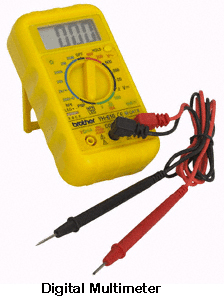
To trouble shoot this, you will need either a multimeter (either digital or analog - you can purchase an digital multimeter from Harbor Freight for under $5 when they go on sale. So I carry one is each car and my tool box.) or a mechanics test light (which you can make your self for about 50 cents). I prefer the volt meter as you get a more accurate reading than the brightness of the light bulb. I will refer to voltmeter, ohmmeter, and multimeter in this article. The are all refering to a multimeter. When I mention a voltmeter, I'm referring to a multimeter set to read at least 12V DC. (If the meter doesn't have a 12V scale, use the 1st setting above 12V.) When I refer to an ohmmeter, I mean a multimeter set to read resistance.
You should also have a "repair manual" for the vehicle. Hopefully it will have a wiring diagram.
For several of the tests, you will need to have a helper sit in the car to turn on the ignition switch to "start" when you tell him to, as you will be under the hood with the volt meter
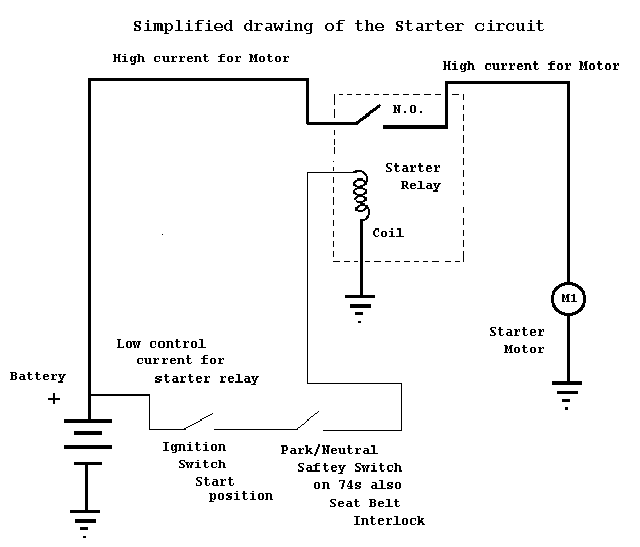
The Basics
I guess we should start with the basics. Refer to the simplified
starter circuit drawing. This one system is basically made up of
2 separate electrical circuits. One circuit carries the high
current from the battery to the starter motor via Normaly
Open (NO) contacts of the starter solenoid or
relay. The other circuit carries the low current
from the battery through the ignition switch (and any addition
safety switches) to the relay's solenoid.
When you turn on the ignition switch, current flows from the battery through the ignition switch and to the solenoid's coil. Very simply put, the coil makes a magnetic field which closes a mechanical switch inside the solenoid case. There are two basic types of starter solenoids:
1. A remotely mounted solenoid. These solenoids are not mounted on the starters and can usually be found on the fender wells. They can be found on most of the cars from the 1970s and before.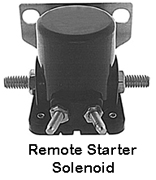
2. The "integrated or attached" solenoid. My way of describing solenoids that are attached or bolted to the actual starter motor. These can be found on pre-engagement starter or on most of the newer front wheel drive cars.
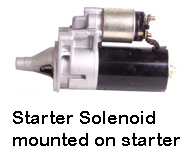
Simple isn't it? But I did leave out a couple of items. Cars equipped with an automatic transmission have a "Park/Neutral" switch that is in series with the ignition switch. If the car is not in Park or Neutral the switch is open and no current will flow to the starter solenoid. The car will not start, nor will you hear the "click" from the starter solenoid.
On 1974 model year cars, U.S. Federal Law required that the seatbelts be connected before the car was allowed to start. So there is effectively a 2nd switch in series with the ignition switch. If this one isn't closed, the car will not start.
Finally, on later cars with manual transmissions (circa 1985) there was a neutral safety switch put on the clutch pedal. If the clutch pedal was not depressed, the car would not start.
I am not going to address a remote start/alarm system in this article.
Now to the trouble shooting:
There are 3 basic symptoms or ways the engine won't turn over when you turn the key to the start position.
Turn the key to the start position and:The clicking:1. nothing happens. This can be caused by a very dead battery, loose connections at the battery cables, the neutral safety switch, bad starter solenoid or bad ignition switch.
2. you get a click, but the engine doesn't turn over. This is usually caused by burnt contacts on the starter solenoid.
3. you get a loud clicking sound, a very rapid click, click, click. etc. Usually due to a weak battery.
Lets start with the easiest problem, there is a loud clicking sound. This is a dead give away that you have a weak battery. When you first turn the key to the start position, there is enough voltage in the battery to close the starter solenoid. And you hear the click. When the solenoid closes its internal switch, the starter is put in the circuit and it starts to draw a lot of current. Since the battery is weak, it can not supply the current, and the voltage drops below the voltage required to keep the starter solenoid closed, and it opens. You will hear a second click. Now that the solenoid is opened, the voltage will rise and the solenoid will re-engage, causing another click. But as before, the starter tries to draw too much current and the voltage drops causing the solenoid to open. This clicking will continue as long as you hold the key in the start position or until the battery is dead.
The solution is to find someone that can jump start your car. You do have a set of jumper cables in the trunk don't you? If that works, and you know you didn't leave the lights on, you need to get your charging system checked. Most of the large auto parts stores (like Advanced Auto and AutoZone will test your system for free).
Note: You can buy a "jump box" for about $50. This is a spare battery pack with rechargable batteries. You keep it in your trunk, so if you have a weak battery, you jump you car yourself.
You hear a loud click when you turn the key to start:
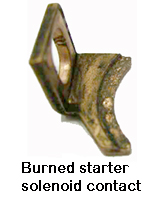 If you hear a loud click but the engine doesn't turn over, you can try turning
the key to off and then start again. This may work. But the problem will
continue and get worse. The most likely problem is burned contacts in the
starter solenoid.
If you hear a loud click but the engine doesn't turn over, you can try turning
the key to off and then start again. This may work. But the problem will
continue and get worse. The most likely problem is burned contacts in the
starter solenoid.
Nothing happens when you turn the key to start:
In many cases, you just drove some place and when you try to leave the
engine won't turn over, check that the automatic transmission is in park.
Try to wiggle the shift lever while trying to start the engine. If that
doesn't work, try putting the shift lever in the Neutral position and see
if the engine won't start. It is possible the Park/Neutral safety switch
is slightly out of adjustment.
(Note: On the newer cars, from around 1996 and later, you can't remove the key from the cylinder unless the car is in park.)
The other possibilities are:
1. That the battery is very dead. Does the radio work? Can you honk the horn? Do the head lights work? If not, then the battery is very dead.In either case 1 or 2, you will have to test the battery.2. There is a bad connection on the cables that connect to the battery or at the other end of these cables.
3. There is a problem with the ignition switch, neutral park safety switch or it's wiring and you will need to test this circuit, Or there is a problem with the starter solenoid.
Testing the Battery
The quickest way to test the battery is to turn on the headlights
and either honk the horn or try to start the car. If the
headlights go very dim or out, chances are that you have a dead
battery.
You can also check the battery using a voltmeter.
When trying to perform many of the tests below, you will want to connect the negative (black) lead from the meter to any metal part of the engine, body, or the negative terminal of the battery. This is called the ground. It might be difficult to hold this negative lead to a ground while you are trying to position the positive lead to take a reading. To make things easy, I use an alligator clip attached to the probe end of negative meter lead, and clip the free end to the ground. (Note: Pre-wired alligator clips are readily available at your local Radio Shack store.)
Connect the negative (black) lead to the negative battery terminal of the battery or any ground and connect the positive (red) lead to the positive battery terminal. With no drain on the battery the meter should read 12 to 13 volts. Have your helper try to start the engine. If the voltage goes below 10 volts your battery is weak.
Try using a set of jumper cables and attaching to another car's battery. If it starts, then your battery needs recharging or replacing. Did you leave the parking lights, headlights, or an accessory light like the trunk, hood or interior lights on. Or you could have a problem with your charging system and it is not charging the battery. In both of these cases, you only have to recharge the battery. However, if your battery is several years old, it could be dying and need replacing. For help here, try jump-starting the car and drive to the closest auto parts store. Most of them can test your battery and charging system for free and will sell you the necessary parts.
With a voltmeter you can perform a quick check of the charging system. Start by turning on the head lights and connect the voltmeter's positive lead to the positive battery terminal and the negative lead to the negative battery terminal. Note the reading, it should be around 12V to 12.5V. If not then the battery is weak. Now start the engine (assuming it will start) and raise the revolutions per minute (RPMs) to about 1500 (a little above idle) by having your helper step on the gas/accelerator pedal just a little bit. If the charging system is working, the voltmeter should read about 13.5V to 14.5V. If not, chances are you have a problem with the alternator (generator) or the voltage regulator. (Note: many of the newer cars (circa 1980 and up) have the voltage regulators built into the alternator or the engine management computer.)
Testing the Ignition switch If you didn't hear the click, we need to find out why. Start by testing the ignition switch circuit wiring. You will have to
find the starter solenoid. The easiest way to do this is to follow the
lead from the positive battery terminal until it connects to something.
This should be the solenoid. The starter solenoid will have several wires
attached to it, 2 very large diameter wires, and 1 or 2 small wires. (Note:
The larger the wire, the more current it can handle.) One large wire goes
to the battery the other goes to the starter. The small wire connecting to
the solenoid is the low current wire and is the control signal for the
solenoid.) Connect the negative lead from the voltmeter and connect it to a good
ground.
Find the small wire connecting to the solenoid and disconnect the wire from
the solenoid. Connect the positive lead from the voltmeter to this wire.
Have your helper try to start the engine. Reconnect the small wire to the
solenoid. Did the volt meter go to 12V?
If no, then try the other small wire. (Depending on the type of solenoid
you have there may be only 1 terminal with a small diameter wire going to it.)
Did you now get 12V?
If yes, then that's a good thing. Your ignition switch and neutral/park
safety switch and wiring are working.
If not, then you'll have to back track to find out why.
If you are working on a '74, ensure that the driver seat belt is connected
and test again.
If you are dealing with a later model car with a manual transmission, is the
clutch depressed? You can check the clutch switch with an ohmmeter. This switch
is usually located on the clutch pedal. Disconnect the wires from the back of
the switch and connect the probes from the ohmmeter to each of the terminals on
the switch. There should be infinite resistance. Now depress the clutch pedal.
The meter should go towards 0 resistance. If the switch did not change resistance,
the it is probably bad. You can also try to bypass this switch using a jumper
wire.
The jumper wire can be any piece of wire from aligator clips to a paper clip.
Remove the wire connector from the switch. If the connector is a female (has
a hole(s) in it, take a paper clip - bend it in a "U" and press the free ends into
each of the holes in the connector. If the connector is male (has metal tabs
sticking out of the connector) you can clip an aligator clip to each of the tabs.
Try to start the engine again.
If not, I'd look at replacing the ignition switch. Since this is a generic
article, I should mention that there are a lot of different ignition switches.
In the older cars (pre 1970), they were on the dash and usually a round switch.
On most newer cars (post 1970) where you put the ignition key is not the
ignition switch. They are usually mounted on the steering column down near
the floor. When you turn the ignition switch there is a rod that goes down to
the switch and actually controls the position of the ignition switch. Sometimes
the ignition switch get loose and is allowed to move slightly. Thus when you try
to start the car, it wonít. Try moving the ignition switch either up or down the
steering column slightly, and retightening the hold down bolts. Also worth
mentioning at this point is that there is a difference in the
ignition switches for tilt and non tilt
steering columns. Testing the Solenoid If yes, then the coil in the relay is OK. IF no, and you have checked: then chances are that the coil in the solenoid is burned out
or you have a bad ground connection. You can test the solenoidís coil. Ensure the ignition is off.
Test the solenoid's input wire from the ignition switch. If it
reads 0V you can proceed with the next test. Set the multimeter
to the Ohms position. Connect the black lead to a
"ground" - almost any metal part on the car. Touch the
red lead to the connector that has the wire from the ignition
switch. If it reads 0 ohms, then the coil is probably OK. If not,
try moving the black lead, from the "ground", to the
metal mounting tab on the solenoid. If the meter reads infinite
resistance, then the coil is open, burned out. Replace the
solenoid. If the meter reads 0 ohms then you have a bad ground or the
coil is shorted. Clean the area around the holes
on the mounting tab and the metal that the solenoid sit on with a
piece of sandpaper until the metal it is shinny and clean. Try
starting the engine again. If you don't here a click then the
wire in the solenoid has shorted out and you
will have to replace the solenoid. If no, you either have a weak battery or a bad connection on
one of the battery cables. Pull both the positive and negative
battery terminals, and clean both the posts on the battery and
the connectors on the cable. (Note: you can purchase a nice
little wire brush for cleaning the upright battery posts at most
auto parts store for under $5. Also, is there some white powder
all over the battery posts? Of so, mix some baking soda and water
and pour the mixture over the battery posts. This will neutralize
the powdered acid on the posts.) Repeat the test. If the voltage drops you probably have a weak
battery. Try jumping the car from another car. If the voltage is above about 9.5 V, then the battery is OK
and so are the connections at the battery are fine. Move the positive meter lead to the other large nut on the
solenoid and have your helper try to start the car. Do you get a above 9.5V? If
yes, the contacts in the solenoid are fine. If no, did the meter show any voltage? If yes,
there is a bad connection at one of the solenoid contacts. (Disconnect the negative lead of the
battery before working on the solenoid.) Remove
both of the large wires from the solenoid. Clean the area around
the holes in the cable with a piece of sandpaper until it is
shiny and clean. Remove the low current wires from the solenoid
and remove the solenoid from the car. Clean the flat metal area
at the base of the large studs, the washers, that go on either
side of the cable, and the end of the battery cable with
sandpaper until they are nice and shinny. Reinstall the solenoid
and the wiring. If no voltage was observed, then the contacts of the solenoid
are probably burned and will have to be replaced. On some
solenoids, you can get replacement contacts, some solenoids you
simply have to replace the solenoid. For an explanation of the burned contacts look at the diagram.
Notice how the input contact has burned away. When the plunger
pulls down, the right side hits the full height output contact and
stops moving downward. However, it can't contact the input
contact because it has burned away. Testing the Starter Motor Move
the positive lead to the large nut on the starter. This is
probably easiest accessed from under the car. (Remember to use
jack stands.) When your helper tries to start the car, do you get
a strong voltage reading (i.e.. greater than 9.5V)? If yes then the output of the solenoid is OK, you have a bad
starter. Most likely it needs new brushes. If no, then you either have a bad connection at the output of
the solenoid, or you have a bad cable from the solenoid to the
starter. End of testing If you attempt to work on the solenoid
or starter, DISCONNECT the NEGATIVE SIDE OF THE BATTERY BEFORE
YOU DO ANYTHING!!
The quickest test of the ignition switch is to turn it to
"start" and listen for the click from the starter
solenoid. If you hear the click the ignition switch is fine.
(Low current side)
When the ignition switched was turned on and you DID get 12V, did
the solenoid go "Click"?
a. on a automatic transmission, the gear shift lever is
positioned in Park,
b. on a manual transmission, the clutch safety switch is working Connect the black (negative) meter lead to a ground
(any metal part of the chassis). Connect the red (positive) lead
to the large nut on the back (pointing to the rear of the car).
There should be 12V there all the time. Have you helper try to
start the engine. Did the voltage stay above 9.5 volts?
Connect the black (negative) meter lead to a ground
(any metal part of the chassis). Connect the red (positive) lead
to the large nut on the back (pointing to the rear of the car).
There should be 12V there all the time. Have you helper try to
start the engine. Did the voltage stay above 9.5 volts? 
 Enjoy your Morgan
Enjoy your Morgan
 John
John
Return to the Index of Tech. articles
To email me with comments or questions.